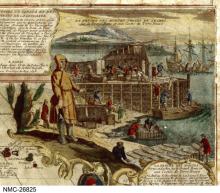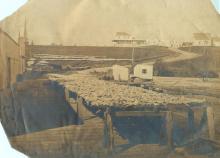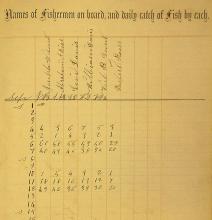History of Fisheries in Maine
Maine’s first fishermen were Native Americans, who caught salmonSalmon
A marine and freshwater food fish, inhabiting North Atlantic waters near the mouths of large rivers. Salmon are anadromous fish, entering rivers to spawn (lay eggs.) In Maine, salmon fishing was once a commercial, then a sport fishery; now wild salmon are an endangered species. Many are farm-raised. and troutTrout
One of the salmon family, it is chiefly a fresh water fish with several species. Some can be anadromous and found in salt water.. Mounds of shells, called middensMiddens
Dump for household waste; shell middens are piles of discarded mollusk shells., tell us that they also ate clamsClam
A shelled mollusk of which there are a number of species. It has a relatively symmetrical oval shell. The dominant Maine clams are soft shelled and live in the mud in the intertidal zone. .
When John CabotCabot, John John Cabot
c.1455-1498. Born in Italy as Giovanni Caboto, he migrated to England and became famous for his 1497 voyage from Bristol, landing on what was likely Newfoundland, the second European to land in America, after Columbus. Returning the following year with 5 vessels, he and his fleet was lost except for one vessel that returned early. Of especial importance was his finding large quantities of cod. crossed the Atlantic Ocean in 1497, he found so many large codCod Gadus morhua
A food fish of the cool water of the North Atlantic: Gadus morhua. The species that was the major attraction for European fishermen to come to America. The stock is now severely overfished with total collapse and closing of the famous cod fishing grounds off of Newfoundland. on the Grand BanksGrand Banks
A large shallow area, rich in fish, located in the North Atlantic off Newfoundland. Publicized by John Cabot's voyage in 1497, this was once perhaps the world's greatest fishing grounds with cod so thick they could be snagged in baskets according to Cabot. The Candian portion of the Grand Banks have been closed to cod fishing as well as the cod fishery along the northern Newfoundland and Labrador coast due to complete collapse of the Northern Cod stock. of Newfoundland that he could scoop them up in baskets. When word of this bounty reached Europe in the early 1500s, BasqueBasque
People inhabiting parts of France and Spain, on the western edge of the Pyrenees, near the Bay of Biscay., Portuguese, Spanish, and French fleets numbering in the hundreds began annual voyages; indeed, some may have preceded Cabot. By the 1540s, the British had passed laws that encouraged English participation in the Grand Banks fishery. This 1698 map of America by Nicholas de Fer shows a cod fishing station.
By the 1600s, Europeans were learning about the significant fish stocks in the Gulf of Maine and along Maine’s coast. Well before the PilgrimsPilgrim
Pilgrims are travelers to sacred places for religion or embark on a quest. In America, the best known pilgrims are the people that left England for America in 1620 and founded the colony at Plymouth. settled the Plymouth ColonyPlymouth Colony
Founded in December 1620 at what is now Plymouth, Massachusetts by English Separatist Puritans.
See also Plymouth Company. in 1620, expeditions like those of Bartholomew GosnoldGosnold, Bartholomew Bartholomew Gosnold
1572-1607. English explorer who sailed to New England in 1602, arriving at and naming Cape Elizabeth, anchoring in York Harbor, then sailing down the coast. He named Cape Cod, then sailed around to Martha's Vineyard, naming it for his daughter. His party was too weak to plant a colony, so all returned.
Read More, Martin PringPring, Martin Martin Pring
c.1580-1646. English explorer, first sent to America in 1603 in a follow-up to Gosnold's voyage in search of sassafras, then thought to be a cure for syphillis. With two vessels, he made landfall in the vicinity of the Penobscot Bay, probably around Matinicus.
Read More, George WaymouthWaymouth, George George Waymouth
c.1585-c.1612. English ship captain and explorer, and student of mathematics, navigation and ship building. In 1602 he led an unsuccessful voyage in search of the Northwest Passage, exploring the area between Greenland and Labrador.
Read More, George PophamPopham, George George Popham
c. 1550-1608 . Merchant and ship captain, nephew of Sir John Popham, Lord Chief Justice of England and one of the prime financial backers of the Popham colony. George Popham was in command and president of the Popham Colony; his death in February, 1608 was a major factor in the colonists' decision to abandon Fort St. George., and especially John SmithSmith, Capt. John Captain John Smith
c.1580-1631. English soldier, sailor, and writer, who became the leader of the Jamestown Colony. Chiefly known in New England for his 1614 voyage in which he mapped much of the coast.
Read More in 1614 reported plentiful fish stocks along the coast of Maine. The coast became a popular summer fishing ground, with 26 ships visiting in the six years before the Pilgrims arrived. Gosnold named Cape CodCape Cod
A landmark for early European explorers, in 1602, Bartholomew Gosnold named Cape Cod for the large number of cod he found off the Cape, on a voyage looking for trading opportunities and fishing grounds. This name was one of the things that attracted the Pilgrims to the Cape in 1620. Cape Cod has been the site of many wrecks of coasting schooners. in 1602, and Smith put it on the map in 1614. This was a factor in the Pilgrims’ decision about a settlement area.
The first permanent settlements in Maine were fishing stations established in the 1620s at Monhegan Island. Other fishing settlements developed on Damariscove Island, Cape Newagen on Southport Island, and Matinicus Island; and at Richmond Harbor, just south of Portland. Though Maine’s maritime population grew slowly in the colonial era, the fisheries remained an important part of the regions’ overall economy. Cod fed the slaves in the West Indies and were sent to cities in colonial America.
After the American Revolution, British markets such as the British West Indies were closed to Americans. The federal government stimulated the fisheries by providing a bountyBounty
A Federal fisheries subsidy, a grant to cod fishermen, from 1792 to 1866. An annual allowance based on vessel tonnage paid to cod fishermen actively fishing for at least four months of the year. In Maine, its major effect was after about 1830, and it formed an important part of cod fishing vessel's earnings. Amendments in 1819 encouraged the kinds of smaller vessels found in Maine., based on the size of the fisherman’s vessel and on the vessel’s annual catch. The bounty helped encourage the New England fishing industry until its repeal in 1866. The log of the schoonerSchooner
A sailing vessel of two or more masts, all fore-and-aft rigged. The Thomas W. Lawson, built in 1902, had seven masts. In comparison to a square-rigged vessel of comparable tonnage, a schooner is better for coastwise sailing. Pioneer, Captain J.W. Blunt, was used to support a bounty claim in 1861.
After the War of 1812, fisheries grew dramatically in both Maine and Massachusetts, which in the mid-nineteenth century vied for the position of top fishing state in the country. After repeal of the bounty, Maine’s share of the cod and mackerelMackerel
Atlantic mackerel is the species found in the North Atlantic. A schooling, bony, oily, strongly-flavored food fish, green above with dark blue bars and silvery color below. The commercial stock has rebounded since near collapse in the 1970s. Without ice they spoil quickly. They are caught in purse seines which produce relatively little bycatch and no bottom damage. Today most of Maine's mackerel fishery is recreational. fisheries dropped dramatically from 45% in 1860 to half that in 1870 and 10% by 1900.



